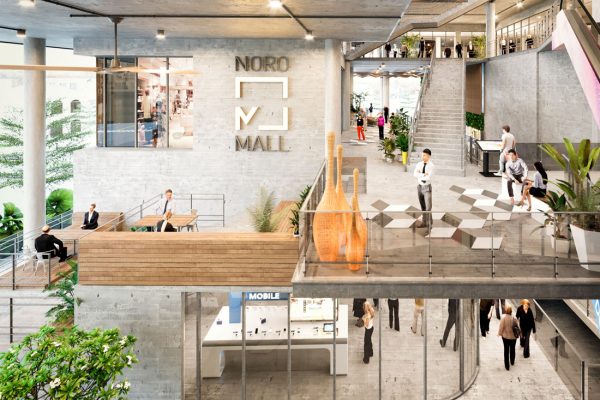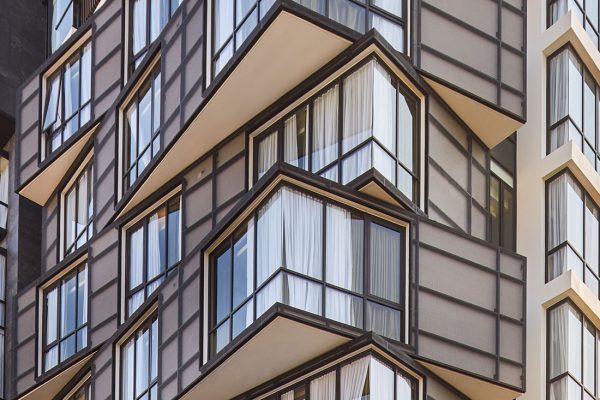As Cambodia’s once-sleepy French-built capital Phnom Penh reinvents itself at an ever-quickening pace, leading architecture firm Re-Edge is finding new ways to stay ahead of the curve.

The interior of Lumiere hotel (left) and Hun Chansan (right). Portrait by KHAMERA/Dy Pech
April 6th, 2018
The meeting room at Hun Chansan’s Re-Edge office, located down a typically leafy road in the centre of Phnom Penh, is ringed by scale models of the works of Vann Molyvann, the Cambodian architect often described as the “man who built Cambodia”.
Responsible for some of the Kingdom’s most cherished structures, including the 1964 ‘Olympic’ Stadium, he was at the forefront of a style known as ‘New Khmer Architecture’, designing more than 100 buildings under the patronage of the late King Norodom Sihanouk.
“Until recently, we didn’t have office buildings, shopping malls and hotels,” says Hun, “but now there is a more global aspect to Cambodia. People travel to other countries, and then come back inspired.” The architect could just as easily be describing himself: on a family visit to Singapore in 1996, aged just 15, his parents decided to leave him in the Lion City with a guardian.
“Cambodia was very unstable at that time. There was an economic crisis, so I was left there and spent a year learning English and Chinese.” Afterwards, he enrolled at a government school, which is where he discovered art.
Quickly developing a passion, he went on to study architecture at Northeastern University in Boston. “Everyone I knew was studying management, marketing or accounting, but I wanted to be something different—not a businessman.” For Hun, the subject held worlds of possibility: “Architecture is not just art—it’s science and innovation, it allows you to tell an audience about who you are. That’s why buildings have to be art, not just functional.”

He references being a fan of the way the narrow subterranean entrance at Frank Gehry’s Guggenheim Museum in Bilbao draws people in, an approach he has flipped on its head with his design for Phnom Penh’s planned Noro Mall, where an open-air plaza will begin your journey through a multi-layered space, crisscrossed with interlocking passageways.
“For instance, I suppose my signature is to chisel away at the traditional block, and break it down into human scale, something that people can relate to and engage with. I like to create movement, and play with light and shadows,” he adds.
This approach is also apparent in his striking design for boutique hotel Lumiere, a kilometre to the north, which provides multiple views of the city from floors twisted at angles to each other, much akin to a Rubik’s Cube in progress.

I’m now curious where the name of his firm comes from. “My master’s thesis was ‘Re-Edging Retails’, and I focused on a bleak urban block in Boston, ‘re-edging’ it and turning it in a different direction, using space to create a feeling of community. Then it was theory—now I’m doing it in practice.”
A searchable and comprehensive guide for specifying leading products and their suppliers
Keep up to date with the latest and greatest from our industry BFF's!

Sub-Zero and Wolf’s prestigious Kitchen Design Contest (KDC) has celebrated the very best in kitchen innovation and aesthetics for three decades now. Recognising premier kitchen design professionals from around the globe, the KDC facilitates innovation, style and functionality that pushes boundaries.

Savage Design’s approach to understanding the relationship between design concepts and user experience, particularly with metalwork, transcends traditional boundaries, blending timeless craftsmanship with digital innovation to create enduring elegance in objects, furnishings, and door furniture.

Channelling the enchanting ambience of the Caffè Greco in Rome, Budapest’s historic Gerbeaud, and Grossi Florentino in Melbourne, Ross Didier’s new collection evokes the designer’s affinity for café experience, while delivering refined seating for contemporary hospitality interiors.
The internet never sleeps! Here's the stuff you might have missed

Third in the series of boutique hotels under the Lloyd’s Inn brand, Lloyd’s Inn Kuala Lumpur bring the immediacy of nature to the new high-rise hospitality experience in the heart of a bustling city.

By adding Muuto to its roster as Singapore’s only retailer, XTRA not only celebrates the enduring appeal of Scandinavian design – it heralds a whole new perspective on its universally appealing legacy.